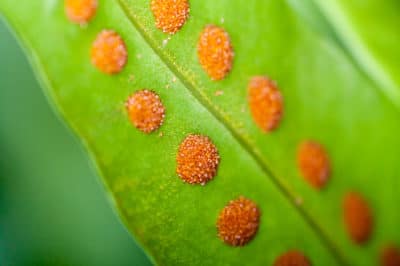About Boston Ferns
Ferns still have characteristics they developed millions of years ago and are often used to illustrate the concept of reproduction through spores. They do not flower or develop seeds. Spores have a distinct survival advantage, as they can remain viable for many years. To some extent, spores in Boston ferns are a back-up mechanism, as the plant can also reproduce from offsets.
Propagating with Spores
This takes time. Here’s how:
- Cut a frond and fold in a sheet of paper; ripe spores will drop within 24 hours.
- Dust spores over sterilized earthworm compost mix; cover with clear plastic.
- Place under cool white fluorescent lights for 14 hours a day.
- Mist green haze that appears after several weeks.
- Two weeks later, transplant small clumps to pots and grow on.
Dividing the Plant
Like most perennials, Boston ferns can be propagated by dividing the original plant. Spread the leaves of your fern and you will see multiple crowns, similar to a clump of daisies or other perennial flowers. Remove the plant from its pot, divide in quarters or eighths with a sharp knife and replant the divisions.
Boston Fern Offsets
Boston ferns will begin to develop offsets if they are healthy and well-established. In the wild, these new plantlets would drop to the soil surrounding the mother plant and send down roots. In this way, the plant would gradually expand, with the healthiest new plants always on the outer perimeter and moving into fresh soil.
Propagating from Offsets
Offsets on a Boston fern look like miniature ferns hanging from a long rhizome, with two to four leaves and a root mass. Cut or pull the offset from the mother plant. Wrap the roots around your index finger and push the root coil into a small pot full of commercial potting soil. Don’t bury the crown. Place in indirect light and mist two to four times a day.
Growing On
New plants from spores, young transplants and divisions need a little pampering. Keep them out of direct sunlight, which can burn leaves. A windowsill or green house with bright indirect light and a shade to keep out full sunlight is ideal. Water to keep the soil moist, but don’t let it get soggy. Do not fertilize young Boston ferns, as they are easily burned by fertilizer.
